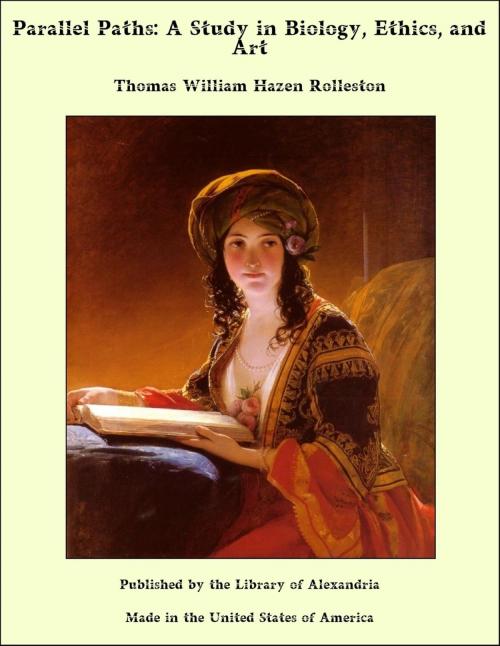Parallel Paths: A Study in Biology, Ethics, and Art
Nonfiction, Religion & Spirituality, New Age, History, Fiction & Literature| Author: | Thomas William Hazen Rolleston | ISBN: | 9781613108772 |
| Publisher: | Library of Alexandria | Publication: | March 8, 2015 |
| Imprint: | Language: | English |
| Author: | Thomas William Hazen Rolleston |
| ISBN: | 9781613108772 |
| Publisher: | Library of Alexandria |
| Publication: | March 8, 2015 |
| Imprint: | |
| Language: | English |
PALEY’S Natural Theology though not by any means an epoch-making may perhaps be called an epoch-marking book. It was the crown of the endeavour of eighteenth-century religious philosophy to found a theology on the evidences of external nature. According to such exact knowledge of Nature’s operations as was then generally available, Paley’s attempt might well be thought to have succeeded. He opens his argument with a striking and effective illustration. He imagines a wayfarer crossing a heath who strikes his foot against a stone, and who asks himself how it came into being. Paley thinks he might be content with vaguely supposing that it was there ‘always.’ But suppose that what he had found at his foot was not a stone but a watch and that he now saw such an instrument for the first time. He would then certainly have not been so easily contented with an answer to the riddle of its existence. He would, if he examined it minutely, have observed that it was a structure intended for a certain purpose, and having all its parts arranged for that object, and mutually interdependent The different substances of which it was composed would be discovered to have each its special appropriateness for the fulfilling of some particular function in the economy of the whole. Though unacquainted with watches he would, if he was a man of sense and cultivation, infallibly conclude that he had before him an instrument intelligently constructed with a certain object in view—the object of measuring the flight of time. He would feel assured of this, even though he should find that the object of the mechanism were not attained with absolute accuracy, and even though there were some parts of it whose functions were not clear to him. The watch would be rightly regarded as a work of design; and the observer would be justified in arguing from it to the existence of a designer, endowed with the faculties of intelligence and conscious purpose, by whom the watch must have been put together. The rest of Paley’s Natural Theology is an application of this analogy to the question of the origin of the universe. Ranging over the whole field of animate and inanimate nature he points to instance after instance of what appears to be the minute and thoughtful adaptation of means to ends, the co-ordination of part with part in the interest of the whole, and he has no difficulty, from this point of view, in showing the world of nature to be a piece of mechanism far more wonderfully and ingeniously constructed than any watch, and bearing prima facie evidence of the most convincing kind of its construction by a Being possessed of intelligence, purpose and foresight precisely resembling those attributes as displayed by man, but vastly heightened and enlarged. As the watch must have been made by man, so a manlike being, endowed with the necessary powers and faculties, must be postulated as the maker of the material universe. And thus the existence of a God made in the image of man appeared to have been demonstrated to the satisfaction of eighteenth-century theology.
PALEY’S Natural Theology though not by any means an epoch-making may perhaps be called an epoch-marking book. It was the crown of the endeavour of eighteenth-century religious philosophy to found a theology on the evidences of external nature. According to such exact knowledge of Nature’s operations as was then generally available, Paley’s attempt might well be thought to have succeeded. He opens his argument with a striking and effective illustration. He imagines a wayfarer crossing a heath who strikes his foot against a stone, and who asks himself how it came into being. Paley thinks he might be content with vaguely supposing that it was there ‘always.’ But suppose that what he had found at his foot was not a stone but a watch and that he now saw such an instrument for the first time. He would then certainly have not been so easily contented with an answer to the riddle of its existence. He would, if he examined it minutely, have observed that it was a structure intended for a certain purpose, and having all its parts arranged for that object, and mutually interdependent The different substances of which it was composed would be discovered to have each its special appropriateness for the fulfilling of some particular function in the economy of the whole. Though unacquainted with watches he would, if he was a man of sense and cultivation, infallibly conclude that he had before him an instrument intelligently constructed with a certain object in view—the object of measuring the flight of time. He would feel assured of this, even though he should find that the object of the mechanism were not attained with absolute accuracy, and even though there were some parts of it whose functions were not clear to him. The watch would be rightly regarded as a work of design; and the observer would be justified in arguing from it to the existence of a designer, endowed with the faculties of intelligence and conscious purpose, by whom the watch must have been put together. The rest of Paley’s Natural Theology is an application of this analogy to the question of the origin of the universe. Ranging over the whole field of animate and inanimate nature he points to instance after instance of what appears to be the minute and thoughtful adaptation of means to ends, the co-ordination of part with part in the interest of the whole, and he has no difficulty, from this point of view, in showing the world of nature to be a piece of mechanism far more wonderfully and ingeniously constructed than any watch, and bearing prima facie evidence of the most convincing kind of its construction by a Being possessed of intelligence, purpose and foresight precisely resembling those attributes as displayed by man, but vastly heightened and enlarged. As the watch must have been made by man, so a manlike being, endowed with the necessary powers and faculties, must be postulated as the maker of the material universe. And thus the existence of a God made in the image of man appeared to have been demonstrated to the satisfaction of eighteenth-century theology.















